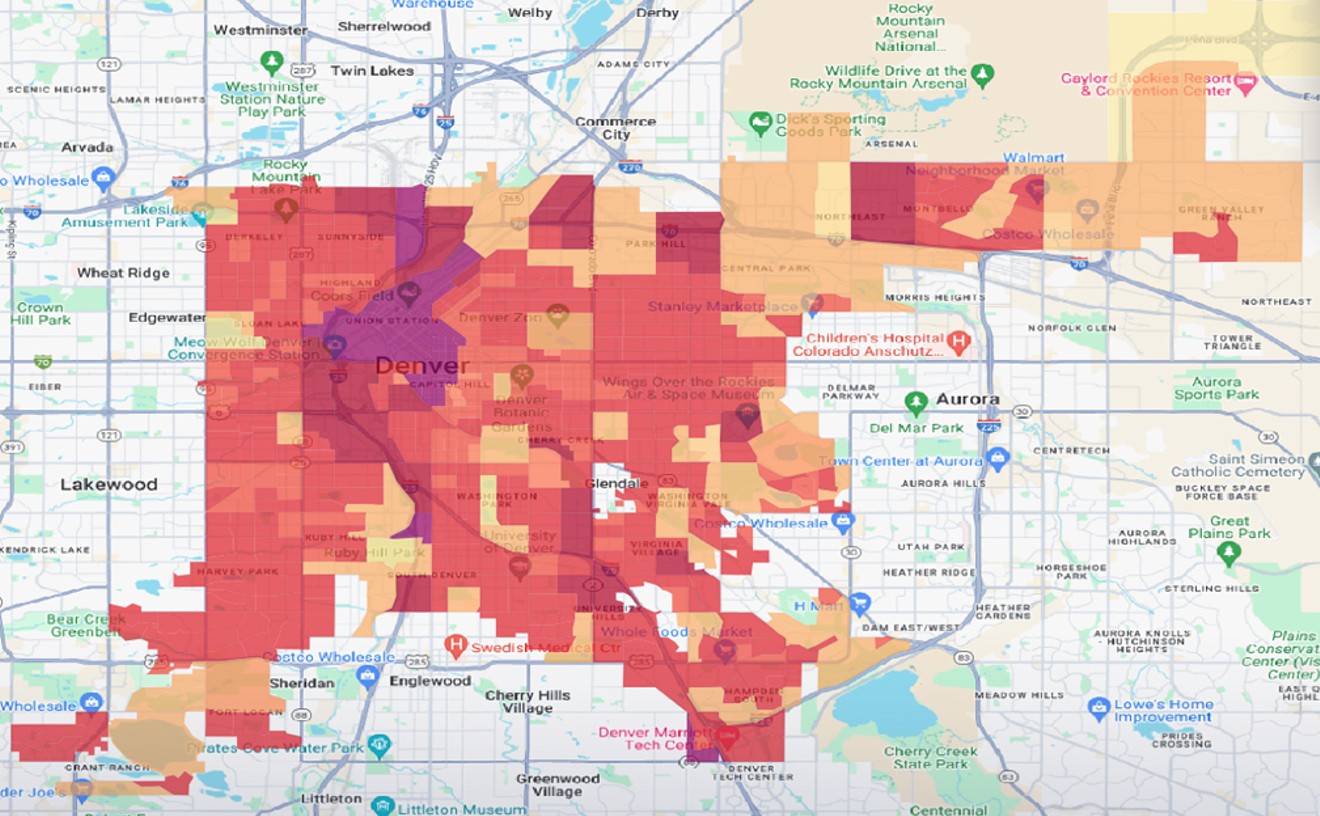The Rocky Flats National Wildlife Refuge opened to the public four years ago, on September 15, 2018. It comprises much of the former Rocky Flats Nuclear Weapons Plant, which created plutonium triggers for bombs and was located sixteen miles upwind from Denver. Fires at the plant in 1957 and 1969 caused some of the plutonium contamination that earned the site Superfund status; after it closed for good in late 1989, the plant was the focus of a $7 billion cleanup before 5,237 acres were reopened to the public. (More than 1,000 acres that had most of the manufacturing operations, known as the Central Operable Unit, remain off limits.)
Even before it opened, stakeholders that included local governments and environmental advocates warned of potential problems at the refuge. Within the last year, it's been the focus of lawsuits filed by groups including Physicians for Social Responsibility and the Rocky Mountain Peace and Justice Center, claiming that the area is not safe for humans because of continued plutonium contamination.
And now another contaminant is on the radar. The Environmental Protection Agency has proposed designating two of the most common PFAS, a set of chemicals sometimes called forever chemicals that build up in the body and may cause negative health impacts, as hazardous substances. On September 5, the agency officially submitted the designation for public comment under the Comprehensive Environmental Response, Compensation, and Liability Act, which oversees Superfund sites.
The two PFAS are perfluorooctanoic acid and perfluorooctanesulfonic acid, which the Colorado Department of Public Health and Environment added to its regulations as hazardous waste constituents in 2018. That year, it notified Rocky Flats management in the Department of Energy that the site likely had PFAS contamination because of its history of fires; PFAS are contained in nearly all firefighting foams.
“PFOA and PFOS can accumulate and persist in the human body for long periods of time, and evidence from laboratory animal and human epidemiology studies indicates that exposure to PFOA and/or PFOS may lead to cancer, reproductive, developmental, cardiovascular, liver, and immunological effects,” the EPA noted in an August release about its decision.
Once the designation is complete, the EPA will require Superfund sites to report the presence of those chemicals, and could require cleanups and better waste management. The EPA has already been looking at PFAS contamination at Rocky Flats in its five-year review of the site.
On July 21, Betsy Smidinger, director of the EPA’s Superfund and Emergency Management Division, wrote a letter to Andrew Keim, Rocky Flats site manager for the U.S. Department of Energy, responding to the five-year plan for the refuge, completed in 2021 and released this year. According to Smidinger, a protectiveness determination for the work needed to make the area safe would not be made because of a lack of information surrounding the risks of PFAS at Rocky Flats to humans and the environment. In each five-year plan, a protectiveness determination is made to assess how effective the cleanup is.
“EPA and our partners at DOE and CDPHE are looking at the occurrence of PFAS compounds in groundwater at Rocky Flats before making any final determinations about risks and potential response actions at the site,” says Laura Flynn Jenkins, media officer for the EPA.
Smidinger’s letter noted that water samples will be collected and analyzed for PFAS over the next two years, an action that the DOE, EPA and CDPHE had already agreed to. The DOE will also implement a plan to assess the risk of PFAS by June 30, 2026, at which point a protectiveness determination will be made. Flynn Jenkins notes that the deferral doesn’t necessarily mean PFAS is a risk at the refuge, just that it must be studied.
“DOE, EPA and CDPHE agreed that four years was a reasonable time to obtain information and reassess the protectiveness determination,” she adds.
The PFAS questions arose the same year the refuge opened. Lindsay Murl, an environmental protection specialist at CDPHE, wrote an email to Scott Surovchak, the now-retired Rocky Flats site manager for DOE, noting that the Rocky Flats Central Operable Unit would need to be tested for PFAS owing to their hazardous-waste designation with the state.
“It is well-documented that the former Rocky Flats Plant had numerous on-site fires and that fire prevention and suppression was a major concern,” Murl wrote in a second email to Surovchak.
By January 2019, the DOE had sent a groundwater sampling plan to the CDPHE. It involved two rounds of sampling at eight locations around the Central Operable Unit; CDPHE approved the plan (with a few modifications) in February 2019.
Sampling began in April 2019 and ended in December, with one report issued in July and another in December; in them, the DOE Office of Legacy Management noted that it had detected PFAS. The contractor hired to conduct the testing, Eurofins TestAmerica, found two instances in which the level of PFOA or PFOS, the two chemicals the EPA is set to designate as hazardous, were above the CDPHE’s 70-nanograms-per-liter safety threshold by at least 50 nanograms per liter.
By December, the rest of the initial sampling was done, but the DOE wasn’t able to get a measure from the surface-water Point of Compliance on Walnut Creek, which runs across the northeast corner of the refuge, because the area was too dry. The CDPHE asked the DOE to continue trying to sample that area. Based on the results thus far, Murl said, CDPHE would likely require continued semi-annual sampling.
According to Laura Dixon, community involvement and communications manager for CDPHE’s Hazardous Materials and Waste Management Division, the formal results of the initial sampling were shared by DOE with the CDPHE in March 2020.
“Due to the site’s corrective action status, CDPHE can, and did, require additional investigation to help the agencies determine where PFOA and PFOS are located,” Dixon says. “After the initial screening effort, DOE agreed to continue testing for PFOA and PFOS at additional sampling points to learn more about the nature and extent of PFAS contamination within the Central Operable Unit.”
DOE’s office of Legacy Management started an expanded PFAS sampling program in 2021; it will sample the water for PFAS on a quarterly basis for two years. A PFAS Strategic Roadmap outline issued on August 18 describes actions it plans to take to prevent and clean up PFAS contamination.
“DOE is committed to collaboration and keeping stakeholders and the public informed about its activities related to PFAS, and we will continue to engage with Federal and state regulators, local communities and tribes regarding PFAS at its sites,” a DOE spokesperson says, without commenting specifically about Rocky Flats.
On August 31, Jon Lipsky, who led the June 1989 raid that halted production of nuclear triggers at Rocky Flats, and Michael Ketterer, an expert in plutonium, sent a letter to the DOE, detailing documents the two had gathered regarding the agency's response to PFAS at Rocky Flats. It discusses uses of PFAS outside of fire suppression, including Teflon equipment that is known to contain PFAS.
"Eight sampling locations were identified, limited to fire department and fire training areas, without corrective action plans. Considering the ~ 1300 acre site of the RFS Central Operating Unit, eight sampling locations cannot, by any means, be considered to a sufficient survey," the letter states.
The letter goes on to advocate for other sampling locations, particularly in areas where Teflon is known to have been used or stored and where waste was stored. It takes issue with DOE management regarding the PFAS problem, particularly when it comes to municipalities close to the refuge that could be contaminated due to PFAS from the water at the refuge making its way into other areas.
"The Rocky Flats Site contains the headwaters for three navigable waters of the US; Rock Creek, Walnut Creek and Woman Creek, capable of transporting PFAS contamination towards inhabited areas in close proximity and beyond," the letter states. The DOE did not reply to questions specific to the letter.
The CDPHE says that PFAS are an emerging concern and that the regulatory landscape is evolving. The policy designating PFAS as hazardous in the state expires in 2025, while the Rocky Flats protectiveness determination has been deferred until 2026.
According to Flynn Jenkins, there are ongoing PFAS investigations at over 100 Superfund sites across the country, and the investigation at Rocky Flats will determine what, if any, actions are needed.
For now, the status of refuge land outside the Central Operable Unit will stay the same, according to Jessica Sutt, public affairs specialist for U.S. Fish and Wildlife, which manages the land that's now been open to the public for four years.
[
{
"name": "Air - MediumRectangle - Inline Content - Mobile Display Size",
"component": "12017618",
"insertPoint": "2",
"requiredCountToDisplay": "2",
"watchElement": ".fdn-content-body",
"astAdList": [
{
"adType": "rectangle",
"displayTargets": "mobile"
}
]
},{
"name": "Editor Picks",
"component": "17242653",
"insertPoint": "4",
"requiredCountToDisplay": "1",
"watchElement": ".fdn-content-body",
"astAdList": [
{
"adType": "rectangle",
"displayTargets": "desktop|tablet"
},{
"adType": "rectangle",
"displayTargets": "desktop|tablet|mobile"
}
]
},{
"name": "Inline Links",
"component": "18838239",
"insertPoint": "8th",
"startingPoint": 8,
"requiredCountToDisplay": "7",
"maxInsertions": 25
},{
"name": "Air - MediumRectangle - Combo - Inline Content",
"component": "17261320",
"insertPoint": "8th",
"startingPoint": 8,
"requiredCountToDisplay": "7",
"maxInsertions": 25,
"watchElement": ".fdn-content-body",
"astAdList": [
{
"adType": "rectangle",
"displayTargets": "desktop|tablet"
},{
"adType": "rectangle",
"displayTargets": "desktop|tablet|mobile"
}
]
},{
"name": "Inline Links",
"component": "18838239",
"insertPoint": "8th",
"startingPoint": 12,
"requiredCountToDisplay": "11",
"maxInsertions": 25
},{
"name": "Air - Leaderboard Tower - Combo - Inline Content",
"component": "17261321",
"insertPoint": "8th",
"startingPoint": 12,
"requiredCountToDisplay": "11",
"maxInsertions": 25,
"watchElement": ".fdn-content-body",
"astAdList": [
{
"adType": "leaderboardInlineContent",
"displayTargets": "desktop|tablet"
},{
"adType": "tower",
"displayTargets": "mobile"
}
]
}
]











